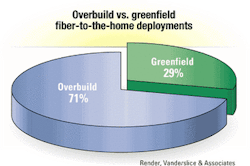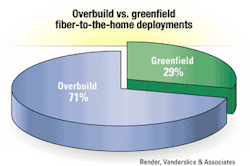Fiber-to-home proponents speak out against negative deployment myths
Many early fiber-to-the-home (FTTH) forecasts, like other sectors of the fiber-optic industry, were predicated on easy financing and readily available and affordable products. Despite some very optimistic forecasting, the number of FTTH deployments announced and underway—sparked by a growing demand for bandwidth by consumers—is difficult to ignore.
Proponents are very encouraged by the recent attention FTTH technologies have garnered in a tough economic climate. According to the FTTH Council (Washington, DC), an association of companies comprising telecommunications, computing, networking, applications, and content and service providers, there are already more than 50 communities in the United States served with FTTH technology and many more are in the construction or pre-construction stage. Although Wall Street and the economy have certainly affected the market, the biggest deterrent to driving fiber to the end user continues to be lack of education, say the FTTH cheerleaders.
One sign that the time for FTTH has arrived would be when overbuilds of traditional copper infrastructure outnumber the greenfield applications for which the technology is best known. According to the council, overbuilds have increased to the point where they at least equal the number of greenfield projects."Greenfield applications are important, but they grow at a slower pace due to the length of time required to fully develop the subdivisions," says James Salter, president of the FTTH Council. "The FTTH Council believes that fiber has begun replacing copper infrastructure. Just look at how deeply fiber already runs into today's existing telephone networks. We also believe that those networks won't be complete until fiber reaches its ultimate destination: the end user."
Of the more than 50 communities on the FTTH Council's list of applications, half are overbuilds by municipalities and even entire counties. According to a recent market analysis report by Render, Vanderslice & Associates (Tulsa, OK), greenfield installations comprise only about 30% of FTTH deployments to date.
And according to the analyst company's president, Michael Render, a second myth about serving only the wealthy with the capabilities of fiber-optic technology can also be put to rest. Render says that while some visible FTTH deployments are upscale areas, the average FTTH community closely mirrors the demographics of the United States as a whole.
That "big picture" appears the same to Optical Solutions (Minneapolis) chief executive Darryl Ponder. "While I can show you fiber to the mansion, I can also show you fiber to the trailer," says Ponder. "FTTH is not an elitist technology; the places served by FTTH represent a cross section of America. I also predict that at least three of the four RBOCs will have FTTH RFQs [requests for quotation] out next year."The variables that compose a particular area's "take rate"—those households that would subscribe to the benefits of FTTH—are many. If services are bundled together, offering a single source (and one bill) for voice, video, and data, the pricing may be easier to swallow for the consumer. That also involves a longer return on investment (ROI) for the average carrier, placing fiber overbuilds years away on some radars. However, there are other markets for FTTH that are much less ROI-conscious. Many rural counties and municipalities are among today's major FTTH projects, and this market segment continues to grow. An example highlighted by the FTTH Council involves four rural counties in Washington State—Chelan, Douglas, Grant, and Mason—where some residents didn't have basic phone service until the counties' municipal utilities deployed FTTH networks.
The Grant County Public Utility District (GCPUD) has passed more than 7,000 homes with fiber, with 2,600 households subscribed to FTTH services and many more awaiting connections. The county plans to reach more than 35,000 homes and businesses by 2005 (see Lightwave, July 2001, page 31). "[There are] more and more rural utility and municipal FTTH overbuild deployments," says Jon Moore, telecommunications manager for the GCPUD. "The rural drivers are not always purely financially motivated; oftentimes, they are tools for aiding economic development, enhancing education and medical access, work-at-home initiatives, and quality of life."
Another hurdle for FTTH may be overcoming the idea that fiber-to-the-business (FTTB) is simply more lucrative for carriers and therefore stands to gain most of the attention as demand for more fiber-optic broadband services becomes apparent. This "myth" may not be a myth at all. The fact is, although proponents of driving fiber to every home are optimistic, the ROI is a critical part of the business case for today's carriers.
"Until someone proves you can make money with it in the residential marketplace, FTTH will be forced to take a backseat to FTTB," says Max Kipfer, executive vice president and general manager at OpenBand of Virginia LLC (Chantilly, VA), a broadband service provider. "As more entrepreneurial FTTH deployments continue, the RBOCs' interest level will increase, but wholesale deployments will take regulatory intervention."
Although FTTH may still lag FTTB in terms of current market, proponents believe FTTH holds much more promise for the future because of its potential impact on the communications industry and the U.S. economy as a whole. Indeed, the key may be in demand—developing killer applications available to the consumer's residence that require the kind of bandwidth only fiber can provide. "There is no residential killer app today that demands fiber," says Moore. "Don't get me wrong, there are applications that take advantage of FTTH—and some that will only work via fiber—but the general public either does not know about these or are willing to get by without them today."
The best news for FTTH is the attention the technology is receiving today, despite a slowly recovering telecommunications industry. According to Render, there are powerful forces at work that may resolve FTTH obstacles in time. The FTTH study by Render, Vanderslice, "Fiber to the Home and Optical Broadband 2002," concludes that although the technology is in its infancy, FTTH is real and growing rapidly. Barring major advances in other types of broadband technologies, FTTH will likely be required to fulfill a need for much greater bandwidth to the residence that is destined to occur in the next few years.


